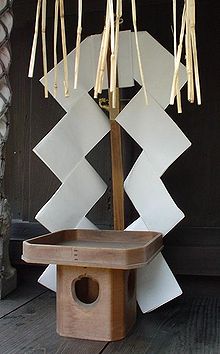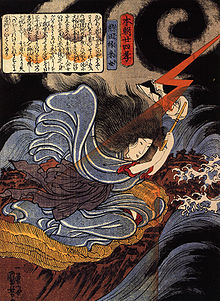- Gohei
-
 Gohei in einem Schrein in Uji.
Gohei in einem Schrein in Uji.
 Ein Mädchen vertreibt eine Jungfrauen fressende Riesenschlange mit einem Gohei. Holzschnitt von Kuniyoshi, 19. Jh.
Ein Mädchen vertreibt eine Jungfrauen fressende Riesenschlange mit einem Gohei. Holzschnitt von Kuniyoshi, 19. Jh.
Gohei (jap. 御幣) sind hölzerne Stäbe, an denen Papierstreifen befestigt sind. In diversen Ritualen des Shintō finden sie Anwendung (insbesondere zur Reinigung) und machen dort einen Typ der heihaku aus.
Die Stäbe selber (gewöhnlich aus Bambus) heißen heigushi, die Papierstreifen in Zickzackform (shide) sind daran angebracht und meist weiß. Diese sind historisch entstanden als Symbole für Kleidung, die ursprünglich als Opfer für die Kami an den heigushi befestigt wurden.
Weblinks
Motosawa Masashi: „Gohei“. In: Encyclopedia of Shinto. der Kokugaku-in, 2. Juni 2005 (englisch)
Wikimedia Foundation.
